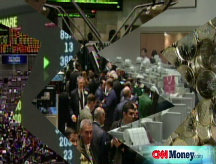Mortgage rates plummet
The $800 billion infusion of federal funds into credit markets has an immediate impact on mortgage rates.
| 30 yr fixed | 3.80% |
| 15 yr fixed | 3.20% |
| 5/1 ARM | 3.84% |
| 30 yr refi | 3.82% |
| 15 yr refi | 3.20% |
NEW YORK (CNNMoney.com) -- Mortgage rates fell sharply yesterday after the administration announced that it will pump another $800 billion into credit markets to free up frozen consumer and mortgage lending.
That number dwarfed previous government actions aimed at bolstering the mortgage lending market.
"The feds agreed to spend a half a trillion dollars to buy up mortgage backed securities and another $100 billion to fund lending for Fannie and Freddie; we're not talking chump change anymore," said Keith Gumbinger of HSH Associates, a publisher of mortgage information.
Rates averaged 5.77% for the day on a 30-year, fixed rate loan, down from 6.06% Monday, according to Gumbinger. They fell as far as 0.75 percentage points during the day, according to Orawin Velz, Associate Vice President for Economic Forecasting at the Mortgage Bankers Association.
That could save a typical homebuyer more than $90 a month on a $200,000 mortgage.
"The government action was geared to bringing mortgage rates down," said Velz, "and it did."
The drop was the largest since early September, when the administration announced that it was taking control of mortgage giants Fannie Mae (FNM, Fortune 500) and Freddie Mac (FRE, Fortune 500), and stemmed from similar market sentiment.
Both actions sought to give confidence to the investment community. Most mortgages are sold to investors in so-called secondary markets but with foreclosure rates so high and expensive write downs of mortgage-backed securities so common over the past several months, investors had fled the mortgage market.
Instead of buying mortgage bonds, they've been snapping up Treasurys, a virtually risk-free investment. That showed up in the falling yields of Treasury bonds and the greater difference between Treasury yields and mortgage interest rates.
Normally, interest rates on 30-year fixed rate mortgages are only slightly higher than yields on 10-year Treasury bonds, about 1.5 percentage points. That difference compensates mortgage investors for taking on extra risk.
Lately, however, because investors have perceived, quite reasonably, that risks of mortgage-backed securities were far greater than previously supposed, they demanded greater reward for investing in them.
That sent the difference, or spread, between mortgage interest rates and Treasury yields to 2 percentage points or so over the past year. That had widened even more recently, to about 3 percentage points, before the government took action yesterday. Even after the big drop in rates, the spread is still more than 2.5 points.
Whether the government action will lead to lower mortgage rates over the long term remains to be seen. "In theory, it should stimulate investor demand but there are a lot of unforeseen things that can occur," said Velz.
She initially thought the Fannie-Freddie takeover would have much the same long-term impact because it meant that the government was guaranteeing all the loans the two were backing.
"But the government started backstopping almost everything," she said, "so demand for mortgages declined and the spread increased again."
This time might be different, according to Mike Larson, a real estate analyst with Weiss Research, but he's far from certain.
"There's been some short-term bang for the buck," he said. "We have to see if it sticks."
Helping it stick could be the downward pressure from deflation concerns and the still unusually wide spread with Treasurys.
"Even if the spread just got a little tighter you'd get some added horsepower," said Larson. "We could see rates in the low fives pretty soon." ![]()



